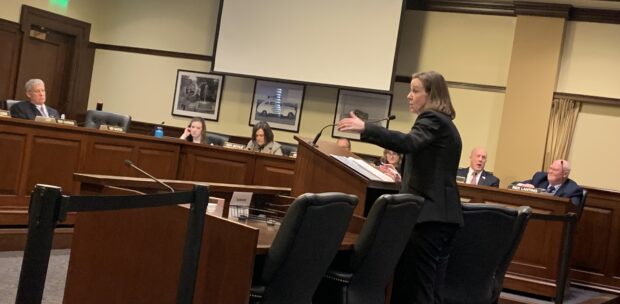It will take seven months for Idaho’s Workforce Development Council to answer the big question on its to-do list: What careers are in-demand careers?
It sounds like a dry topic. But it’s actually a hot topic. The in-demand careers list could affect thousands of high school seniors. And it will shape Gov. Brad Little’s fledgling Idaho Launch plan, which will provide millions of dollars in incentives designed to entice these young adults into job vacancies that Idaho employers are struggling to fill.
Whatever that turns out to mean.
This really is a big deal. But you couldn’t really tell from looking Wednesday morning, as the council worked in its accustomed obscurity.
The group met in a cavernous and mostly unfilled conference room — in an office complex that once served as headquarters for Morrison-Knudsen, one of Boise’s old guard corporate pillars. The council’s audience, such as it was, consisted mostly of a handful of lobbyists and a single reporter. This ratio suggested a run-of-the-mill legislative committee meeting from any random winter weekday. The room’s rows of work desks resembled a college lecture hall.
And perhaps that was fitting, since the council’s initial discussion of in-demand careers felt a bit like a tutorial.
Hope Morrow, an economist from the Idaho National Laboratory, walked her fellow council members through the process that will define an in-demand career — and steer Idaho Launch incentives of up to $8,000 per student.
At first glance, the metrics sound straightforward enough. The in-demand career definition hinges on two yardsticks: annual job growth exceeding 10% a year, and more than 100 openings per year.

Those criteria will likely take in just about everything in health care, Workforce Development Council Executive Director Wendi Secrist said Wednesday. Meanwhile, Morrow ran through a list of occupations unlikely to make the cut — from lawyers and librarians to (go figure) media and communications.
Things get a little bit more gray elsewhere. Logging jobs are in decline, the result of automation, but the remaining jobs are vitally important to the North Idaho economy — and the jobs require a high skill set. The council could give itself some wiggle room by making “emerging or transitional occupations” eligible for a slice of the Launch incentives, which could reach $80 million a year.
Council members didn’t even start writing the hot list Wednesday. They have time; their list isn’t due to the Legislature until Jan. 1. But things are moving quickly on the Launch startup; high school seniors will be able to begin applying for a share of the money on Oct. 1, so recipients can get their money after graduation next spring.
Or to put it another way, the Class of 2024 will be able to start applying for in-demand careers incentives three months before the state actually comes up with a list of eligible careers.
The timing of the Workforce Development Council’s Jan. 1 deadline is significant for another reason. It comes a week before the start of the 2024 legislative session, and a new round of debate over Launch. The Launch bills barely squeaked through the 2023 Legislature — with critics saying the plan smacked of socialism and cronyism — and the opposition isn’t going anywhere.

On Wednesday, the council even had a problem with one of its Statehouse allies: House Majority Leader Megan Blanksma, who sat in the back of the meeting room, listening to the in-demand careers discussion. During a break in the meeting, Blanksma didn’t say much, saying she wanted to have a conversation with Secrist. But Blanksma did nothing to hide her dismay.
“What they’re doing right now does not align with the legislative intent, with the bill that I helped author,” said Blanksma, R-Hammett.
The council can ill afford to lose the friends it does have in the Legislature. During the Launch debate last year, the council became an easy target for critics, who conjured the image of a faceless, unelected bureaucratic body picking winners and losers in the labor market.
For council chair Deni Hoehne, those heated legislative committee hearings still sting. On Wednesday, the WinCo Foods administrator urged her colleagues to sharpen up their “elevator speech” touting Launch — and pass on any criticisms and concerns they hear along the way. The backlash, she said, underscores the need for transparency between now and the Jan. 1 deadline.
“Our ability to document this process is critical,” she said. “We want to do this right.”
The 33-member council is made up largely of industry and business leaders. But not exclusively. State superintendent Debbie Critchfield and State Board of Education President Linda Clark sit on the council, along with two lawmakers from the House and Senate education committees: Rep. Lori McCann, R-Lewiston, and Sen. Carrie Semmelroth, D-Boise.
During Wednesday’s meeting, council members seemed to be trying to get their minds wrapped around the new program — and how to measure success. The Legislature already put performance measures into the law: completion and job placement rates, demographic breakdowns, and a tally of how many Launch recipients stay in Idaho. Council members seemed to want more details.
College of Eastern Idaho administrator Lori Barber said she wanted to see some exit interviews with Launch recipients who don’t complete their education or job training, to understand what went wrong. “It’s a really hard group, because sometimes they just disappear,” she said.
Clark, a former West Ada school superintendent, noted that Launch is a complicated program that will allow students to go to community college or pursue a career-technical certificate or workforce training. Unlike a traditional college scholarship, where success can be measured largely by tracking student GPAs, Launch is different. “There are a zillion scenarios.”
In the coming months and years, the Workforce Development Council will play a central role in Launch. The council will help implement — and track — an ambitious effort to provide thousands of dollars apiece to thousands of young Idaho adults, year after year.
It’s a vital role. Even if nobody seems to be watching.
Kevin Richert writes a weekly analysis on education policy and education politics. Look for his stories each Thursday.
